Related Research Articles

George William Peppard was an American actor. He secured a major role as struggling writer Paul Varjak when he starred alongside Audrey Hepburn in Breakfast at Tiffany's (1961), and later portrayed a character based on Howard Hughes in The Carpetbaggers (1964). On television, he played the title role of millionaire insurance investigator and sleuth Thomas Banacek in the early-1970s mystery series Banacek. He played Col. John "Hannibal" Smith, the cigar-smoking leader of a renegade commando squad in the 1980s action television series The A-Team.

John Arthur Kennedy was an American stage and film actor known for his versatility in supporting film roles and his ability to create "an exceptional honesty and naturalness on stage", especially in the original casts of Arthur Miller plays on Broadway. He won the 1949 Tony Award for Best Featured Actor in a Play for Miller's Death of a Salesman. He also won the Golden Globe for Best Supporting Actor for the 1955 film Trial, and was a five-time Academy Award nominee.
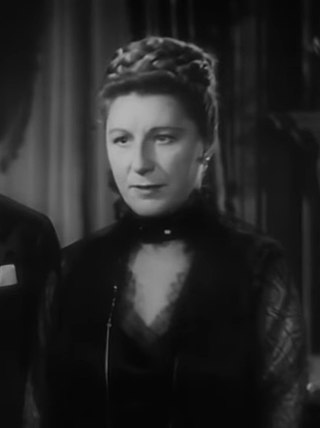
Dame Frances Margaret Anderson,, known professionally as Judith Anderson, was an Australian actress who had a successful career in stage, film and television. A pre-eminent stage actress in her era, she won two Emmy Awards and a Tony Award and was also nominated for a Grammy Award and an Academy Award. She is considered one of the 20th century's greatest classical stage actors.

Sandra Louise Anderson, professionally known as Sondra Locke, was an American actress and director.
John Lee Thompson was a British film director, active in London and Hollywood, best known for award-winning films such as Woman in a Dressing Gown, Ice Cold in Alex and The Guns of Navarone along with popular and cult pictures like Cape Fear, Conquest of the Planet of the Apes, Battle for the Planet of the Apes and The White Buffalo.
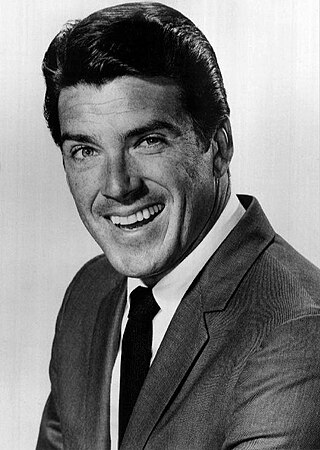
Van Zandt Jarvis Williams was an American actor best known for his leading role as Kenny Madison in both Warner Bros. television detective series Bourbon Street Beat (1959–1960) and its sequel, Surfside 6 (1960–1962). He teamed for one season with Bruce Lee as his partner Kato, in the television series The Green Hornet, which was broadcast during the 1966–1967 season.

Dana James Hutton, known as Jim Hutton, was an American actor in film and television best remembered for his role as Ellery Queen in the 1970s TV series of the same name, and his screen partnership with Paula Prentiss in four films, starting with Where the Boys Are. He is the father of actor Timothy Hutton.
The Shark Arm case refers to a series of incidents that began in Sydney, Australia, on 25 April 1935 when a human arm was regurgitated by a captive 3.5-metre tiger shark, resulting subsequently in a murder investigation and trial.

Janet Munro was a British actress. She won a Golden Globe Award for her performance in the film Darby O'Gill and the Little People (1959) and received a BAFTA Film Award nomination for her performance in the film Life for Ruth (1962).
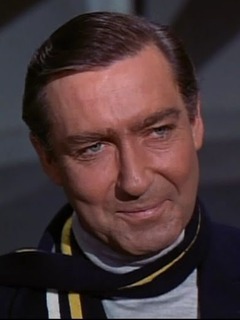
Guy Doleman was a New Zealand born actor, active in Australia, Britain and the United States. He is possibly best remembered for being the first actor to play Number Two in the classic cult series The Prisoner.
Sumner Locke Elliott was an Australian novelist and playwright.
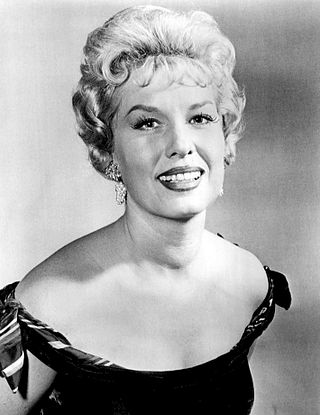
Jean Donahue was an American film and television actress. She appeared in approximately 65 films in her 38-year career.
Reginald Thomas Lye, was an Australian actor who worked extensively in Australia and England. He was one of the busiest Australian actors of the 1950s, appearing in the majority of locally shot features at the time, as well as on stage and radio. Lee Robinson called him "one of the best character actors in Australia." He moved to England in the early 1960s,, but returned to Australia when the film industry revived in the 1970s.
The General Motors Hour was an Australian radio and television drama series.

Ken Scott was an American actor best known for his work in the film industry during the 1950s, and career in television beyond that.
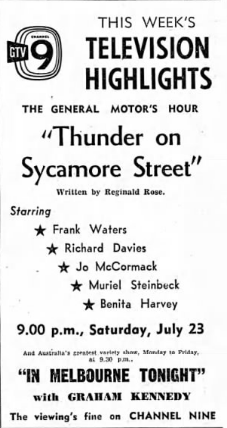
"Thunder on Sycamore Street" is a 1960 Australian television play directed by David Cahill. It was based on a script by Reginald Rose. It aired on 23 July 1960 in Melbourne and Sydney.
"The Grey Nurse Said Nothing" is a television play episode from the Australian television series The General Motors Hour. It was produced and directed by David Cahill. It was made by Channel Seven who later called "the most ambitious dramatic production ever attempted in Australia... [written by] one of the world's foremost authors of television plays and the cast is Ihe largest ever assembled for an Australian television dramatic production.... the greatest care has been taken to achieve the maximum possible standard in the production of the play which covered a total period of approximately eight weeks." The episode aired on 28 May 1960 in Sydney and Melbourne, and on 11 June 1960 in Brisbane.

Margaret P. L. Pierce was an American nurse and model who then became a film and television actress. A former MGM contract player, she had a starring role on the 1965-1966 television series My Mother the Car.

Death in Small Doses is a 1995 American true crime television film directed by Sondra Locke and written by Scott Swanton. It was produced by Robert Greenwald Productions and stars Richard Thomas, Tess Harper, Glynnis O'Connor and Shawn Elliot. The film is a dramatization of the 1991 death of wealthy Dallas resident Nancy Lyon by arsenic poisoning, a crime for which her husband Richard Lyon (Thomas) was the police's main suspect.
References
- ↑ Television Preview The Washington Post and Times-Herald ]26 Nov 1959: D23.
- 1 2 Vagg, Stephen (17 November 2020). "Forgotten Australian TV Plays: The Grey Nurse Said Nothing". Filmink.
- ↑ "A TV drama recalls the Shark Arm Murder". TV Times. 9 June 1960. pp. 8–9.
- ↑ Shanley, John P. (27 November 1959). "TV Review: Murder Trial Is Basis for Suspenseful Show". New York Times. p. 59.
- ↑ Staccato Format Is Still Bad Anderson, Robert. Chicago Daily Tribune 1 Dec 1959: b10.